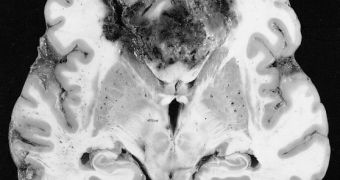A new study published recently in the New England Journal of Medicine, shows that losing a gene called NFKBIA (nuclear factor of kappa-light polypeptide gene enhancer in B-cells inhibitor-alpha) promotes the growth of glioblastoma multiforme, and suggests that therapies that stabilize this gene could increase survival rates for certain patients.
Glioblastoma multiforme is the most common and deadly form of primary brain tumor in humans, involving glial cells and accounting for 52% of all parenchymal brain tumor cases and for 20% of all intracranial tumors.
Senior coauthor Dr. Arnab Chakravarti, chair and professor of Radiation Oncology and co-director of the Brain Tumor Program at the Ohio State University Comprehensive Cancer Center-Arthur G. James Cancer Hospital and Richard J. Solove Research Institute, said “that NFKBIA status may be an independent predictor of survival in certain patients with glioblastoma.
“We also show that this gene plays a key role in glioblastoma behavior, and that it could be useful for predicting treatment outcomes,” he adds.
Along with Markus Bredel, an adjunct associate professor of radiation oncology at Ohio State and their colleagues, Chakravarti analyzed data from 790 cases of glioblastoma, that they divided into 10 study sets for gene deletions, mutations, and expression of NFKBIA and EGFR.
They used glioblastoma cell lines and tumor cells from patients and examined the influence of the NFKBIA gene on tumor-cell growth and sensitivity to temozolomide – the most effective chemotherapy for glioblastoma.
At the end, they compared these results with the outcomes of 570 glioblastoma patients, and concluded that restoring NFKBIA in tumor cells prevented their growth and viability and increased the cells’ sensitivity to temozolomide.
Also, restoring NFKBIA inhibits the growth of glioblastoma cells that are driven by overexpression of EGFR.
And finally, patients with both copies of NFKBIA survive far longer than did patients with tumors that have lost a copy of the gene – 131 weeks compared to 57 weeks.
Every year, in the United States, nearly 18, 500 new cases of glioblastoma are diagnosed, resulting in 12,760 deaths, and the average survival period after diagnosis is 12 to 15 months.
In most cases, the disease is triggered by an over activity of the gene called EGFR (epidermal growth factor receptor), but this study shows that both the loss of NFKBIA and the overexpression EGFR are equal triggers of glioblastoma development.
However, glioblastoma tumors can present either abnormally high levels of EGFR or loss of NFKBIA, but never both.
The research was published recently in the New England Journal of Medicine.

 14 DAY TRIAL //
14 DAY TRIAL //